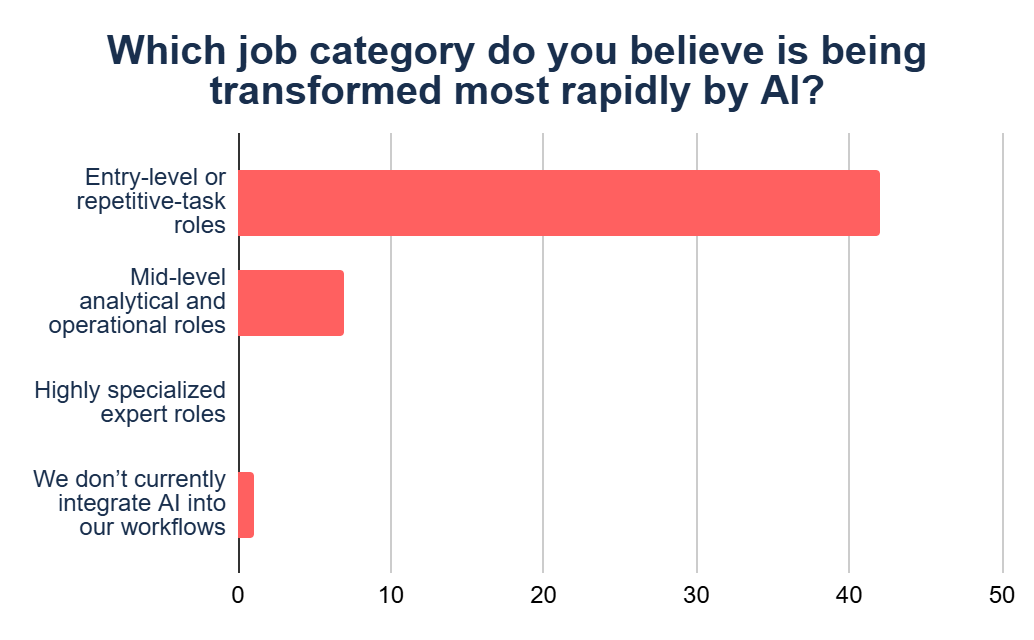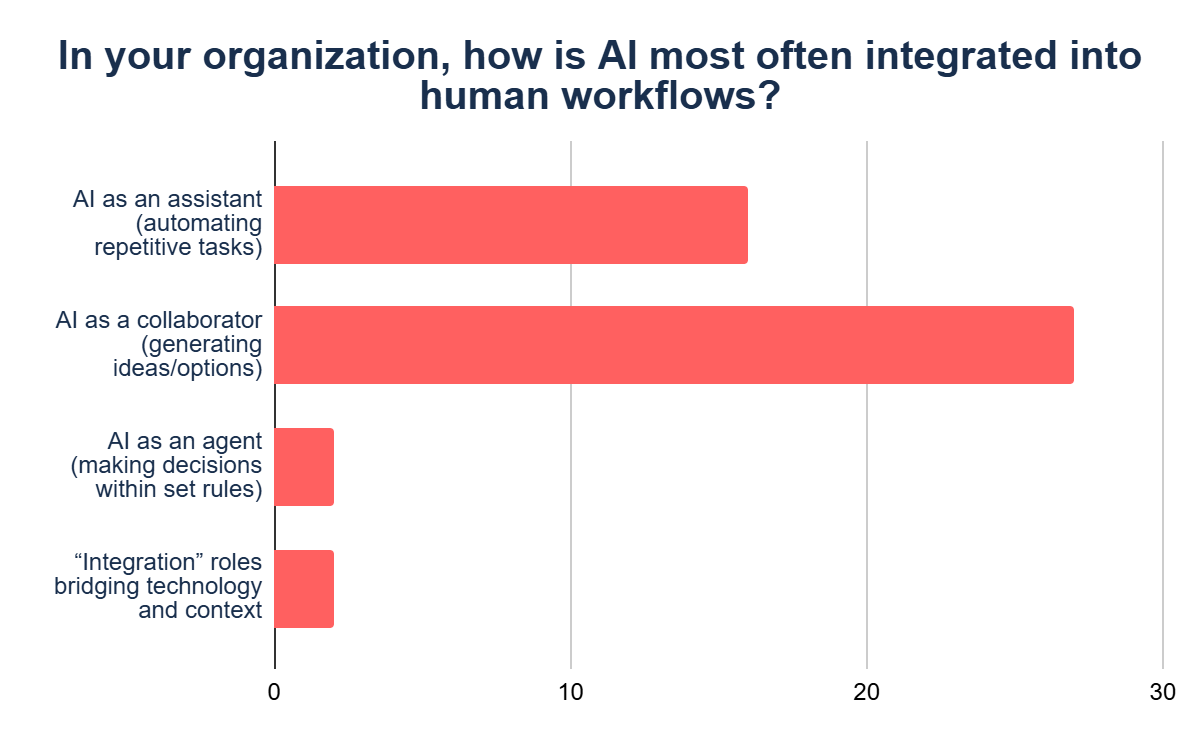Designing for the unknown: Organizational structures in the age of AI
.png)
Artificial intelligence isn’t just reshaping how we work, it’s redefining the very scaffolding of organizations. From decision-making speed to the flattening of hierarchies, from the evolving role of managers to whether AI should be treated as a “role” or a “tool,” HR and people leaders face profound questions about the workplace of the future.
In a recent Lepaya webinar, Missy Strong, Senior People Experience Lead at Pigment; Toni Cairns, Founder of YellowBox; and Milda Bayer, VP of GTM & Marketing at Lepaya shared their perspectives on how organizational structures are evolving under AI’s influence. Here are the key takeaways.
Will AI accelerate the flattening of organizational structures?
For decades, organizations debated whether to be flat or hierarchical. But according to the experts, this framing is outdated. In the age of AI, the real challenge is whether structures enable speed, adaptability, and human connection.
“Org structure is a little bit of scaffolding, and to me, what matters most is how people actually move through it.” – Missy Strong, Pigment
The scaffolding metaphor captures an essential truth: it isn’t the shape of the chart that matters, but whether employees can navigate it to make decisions in time, build trust at scale, and preserve meaningful human connection.
AI is already accelerating this need for speed. It can handle note-taking, task-tracking, and meeting follow-ups, giving employees more bandwidth for high-value work. But AI’s deeper impact is cultural - it pressures organizations to strip away unnecessary layers and clarify decision rights.
“We don’t want people sitting in meetings all day and wasting their time… everyone in this meeting is in charge of the cost of the use of that time.” – Missy Strong
This pressure is visible at scale. Tech giants like Amazon are openly pursuing leaner spans of control, demanding that managers handle larger teams or disappear altogether.
“That trend towards flattening… has actually been an ongoing trend. What AI is doing is accelerating it.” – Toni Cairns, YellowBox
The implications for managers are profound. Traditional middle management - once valued for oversight, reporting, and process enforcement - is increasingly automated. In its place, a new archetype of manager must emerge: one who acts as a coach, enabler, and capability-builder. Their success will be measured not by the size of their teams, but by the adaptability and resilience of those teams in fast-changing environments.
This evolution will not be painless. In legacy organizations, removing layers risks creating chaos, especially without clear accountability mechanisms. Yet the alternative - clinging to slow, bureaucratic structures - may be even riskier in an AI-driven economy.
The disruption of junior roles and the future of talent pipelines
Perhaps the most disruptive effect of AI lies in the entry point to work. Traditionally, junior hires and interns built their skills through repetitive, process-heavy tasks. Today, AI performs much of that work.

“Young people today are struggling to land internships because so much of the administrative work that used to teach the craft of the job is being outsourced to AI.” – Milda Bayer, Lepaya
This erosion of entry-level pathways could fundamentally shift how companies develop talent. Instead of internships centered on paperwork and operations, apprenticeship-style models may become the norm, with new hires embedded directly into higher-value tasks under close mentorship.
“You don’t come in anymore to learn bookkeeping… that’s what AI does. Just like we don’t need to teach children to calculate cosine manually, we have calculators for that.” – Toni Cairns
The pattern is clear: jobs don’t vanish entirely - they transform. While narrow, repetitive roles, especially at the entry level, face the highest risk of displacement, new opportunities are opening up in “integration roles” that connect technology with business context, such as AI product owners and workflow designers. Even the C-suite is evolving, with companies now experimenting with positions like Chief AI Officer.
AI in the workplace: A role or a tool?
Perhaps the most provocative question on HR leaders’ minds is whether AI should be treated as a role within organizations, or simply as a tool.
“Do you call an AI agent a role? If it’s a customer service agent, does it have a role, a manager, KPIs? Or is it just a tool and platform? That actually has an impact on how you design an organization structure.” – Toni Cairns

AI already operates in three ways:
- Assistant – Automating repetitive tasks (e.g., answering HR questions)
- Collaborator – Generating ideas and creative options
- Agent – Making autonomous decisions within defined constraints
“Can "an AI" be made responsible? If it is yes, I think it could be a "role". If not, then it is a "tool",” Stefan, webinar attendee.
“I think the future of work is heading toward individual contributors managing AI agents. So instead of just doing the work themselves, ICs will be orchestrating and overseeing agents to get things done.” Christopher, webinar attendee.
The distinction is more than semantic. How leaders classify AI - whether as “headcount” or “infrastructure” - reshapes reporting lines, accountability, and even cultural norms.
When companies get it wrong, the consequences are immediate. One organization handed over all marketing content creation to AI, only to see a flood of inaccurate and hallucinated outputs that damaged trust. The problem wasn’t the tool itself, but the lack of human oversight.
“It should have been seen as an enabler, not a replacement.” – Toni Cairns
“As a people experience designer, it’s all about AI in the workflow. The first step is psychological safety, helping employees understand not just what AI is used for, but why leadership wants to use it.” – Missy Strong
If AI is elevated to a quasi-“role,” organizations must build systems of governance and accountability around it. If it is treated as a tool, leaders must double down on embedding it into workflows responsibly.
Future-proof skills: What to invest in now
If AI is redrawing job categories, what makes a career resilient? The experts pointed to T-shaped skills - deep expertise in one area, combined with broad fluency across others.
“Durability of your career is about deepening your core expertise while broadening your AI fluency, data literacy, and change management skills… then stretching diagonally into adjacent areas.” – Missy Strong
According to the experts, these are the key future-proof skills to focus on:
- AI literacy – Not coding, but fluency in prompts, tool selection, and limitations
- Critical thinking and judgment – Challenging AI outputs, spotting contradictions, and weighing trade-offs
- Integration skills – Designing workflows where AI and humans complement each other
- Ethical guardianship – Ensuring AI aligns with values and ethics
- Creativity and empathy – Uniquely human skills that grow more valuable as automation expands.
Designing for the unknown
The future of organizational structures may not hinge on being flat or hierarchical, but on whether they are fast, human-centered, and adaptable enough to thrive in an AI-powered world.
Companies that succeed will:
- Redesign management as coaching rather than oversight
- Reimagine junior roles as apprenticeships in judgment and creativity
- Treat AI as an enabler, not a replacement
- Invest in strengthening human skills like critical thinking, creativity and empathy.

Nous proposons une solution évolutive de formation des employés. Elle vous permet d'améliorer en permanence les compétences de votre personnel.
Réservez un appel
Related articles
Ready to drive impact together?
Close skill gaps, accelerate growth, and future-proof your workforce.












.jpg)


.png)
.png)